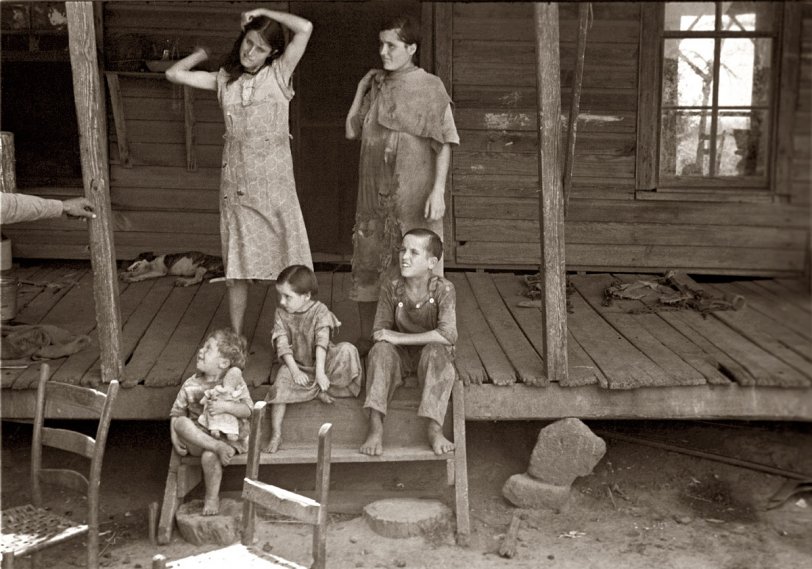


Framed or unframed, desk size to sofa size, printed by us in Arizona and Alabama since 2007. Explore now.
Shorpy is funded by you. Patreon contributors get an ad-free experience.
Learn more.

- Texas Flyer wanted
- Just a Year Too Soon
- WWII -- Replacing men with women at the railroad crossing.
- Yes, Icing
- You kids drive me nuts!
- NOT An Easy Job
- I wonder
- Just add window boxes
- Icing Platform?
- Indiana Harbor Belt abides
- Freezing haze
- Corrections (for those who care)
- C&NW at Nelson
- Fallen Flags
- A dangerous job made worse
- Water Stop
- Passenger trains have right of way over freights?
- Coal
- Never ceases to amaze me.
- Still chuggin' (in model form)
- Great shot
- Westerly Breeze
- For the men, a trapeze
- Tickled
- Sense of loneliness ...
- 2 cents
- Charm City
- What an Outrage
- Brighton Park
- Catenary Supports
Print Emporium
The Summer of ’36

Summer 1936. Children of sharecropper Frank Tengle at their Hale County, Alabama, cabin. View full size. 35mm nitrate negative by Walker Evans.
Life as a Sharecropper
This photo brings my parents' childhood to life for me. Both are children of Alabama sharecroppers, and became sharecroppers also. My father attended school until the 2nd grade, and then worked in the fields until he was drafted for WWII at the age of 18. Girls often attended school, since many of the girls could not perform as well in the fields. Many times the children did not have shoes. Animals could go through the house at will. Clothes were made from croker sacks. Fruit was the usual holiday gift for children. Meat was not common at meals. Families attempted to raise and store produce to make it through the year. One of my grandmothers was physically handicapped and raised three children in this environment. Many fathers were alcoholics and spent what little money they came across on booze. After WWII, my parents left Alabama for good with little more than a single suitcase. My father, having learned to read and write in the Army, led a very successful life. My generation was the first to be born in hospitals and graduate from high school. This photograph does not exaggerate the life of a sharecropper's family during the 30's in Alabama.
Same as today
uneducated, stupid, selfish people having children they cant feed or cloth properly.. b/c wasnt invented , i know but there was abstinence.
[I wonder if they were so moronic that they couldn't spell "clothe." - Dave]
LUNPFM
"Let Us Now Praise Famous Men" may be the most famous photo-essay book of the 20th century today but it certainly wasn't in its time. If I recall correctly it sold only a few hundred copies. Neither Agee nor Evans had achieved the fame they later achieved at the time of the book.
Comparison II
My dad is from the South about this time and this was still in the Depression. He said he was lucky to have one pair of shoes a year and they didn't wear them except to go to school or something. My Dad talked about finding a five dollar bill and it was a joyous occasion. That money bought all three kids (him and two brothers) clothes and shoes for the year. It was a sad time when people were doing without and doing the best they could.
Comparison
I am African-American, born around this time and lived in the South. We were not affluent by any means, but we were never this poor. I attribute this to the luck of being in a more prosperous city with a never-failing industry (tobacco) where there was always employment available.
Disagree
According to James Agee, Evans allowed the mothers to clean up their children, if they desired, before he photographed them. Candid shots were not to be achieved at the cost of shaming the families beyond the shame they already felt
Is it propaganda somewhat?
I know these people were as poor as they appear, but I do have a feeling the photographer wanted their worst clothes on, don't you? I mean the way she appears to be brushing her hair, and the other lady seems to be adjusting her rags, it just seems so staged. But don't get me wrong, my own mother and father lived this at this very time in Oklahoma, with dust to boot. I know it is real.
[The Tengle family, along with their neighbors the Fieldses and the Burroughses, were the subject of the book "Let Us Now Praise Famous Men" by James Agee and Walker Evans, probably the most famous photoessay the 20th century. You might want to give it a read. This picture, one of the photographs in the book, is in the archives of the Library of Congress. - Dave]
























On Shorpy:
Today’s Top 5